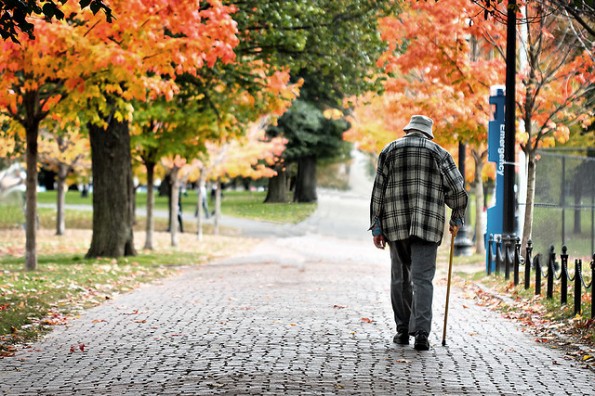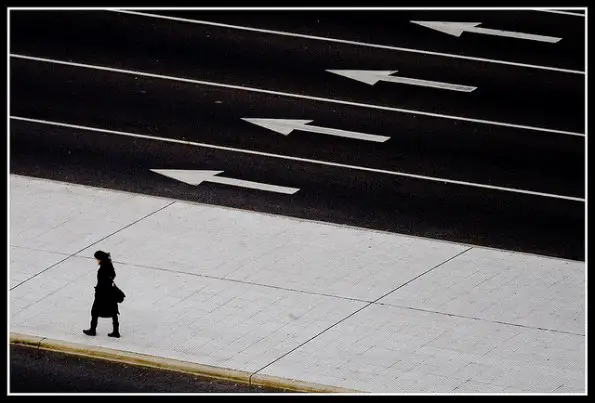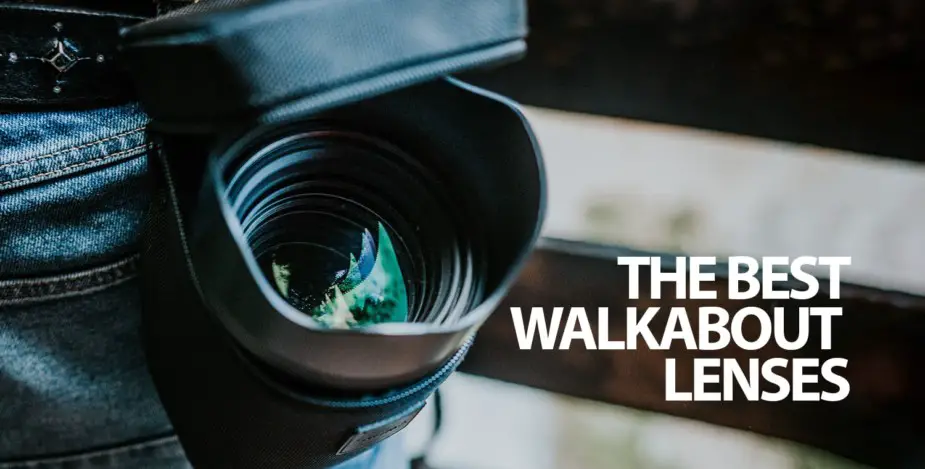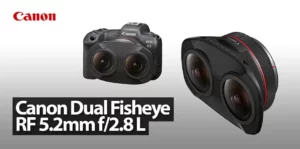In this article, we’re looking at choosing the Best Walk Around lens for your camera. Whether it’s a Nikon, Canon, Sony, or FujiFilm camera, having a good walk-around lens allows you to have fun while taking photographs.
If you’re buying your first serious camera, you are probably considering the purchase of a single lens that allows you to do ‘everything’ as you go about your daily life. This kind of lens is called a “walk around lens” or “walk around lens”. In this article, I’ll use those terms interchangeably… Now, let me help you understand what your first multi-purpose lens should be able to do for you, and why.
The Need For A Walk Around Lens

A walkabout lens needn’t have the best quality output, but it does have to be sturdy and versatile. Most people buy their new interchangeable-lens camera with the kit lens, or a 50mm prime lens.
Those aren’t bad options… But if you’re moving on from a point-and-shoot camera, it could leave you feeling like your brand-new mirrorless camera is less capable than your old point-and-shoot camera. That’s certainly not the case, but it is more complex. And that’s why lens selection is also a little more complex. We have a bunch of articles just to answer these complex questions, but this is a beginner article, for a beginner topic, so let’s keep things simple.
So, what do you need to do to buy the best all-purpose lens for your first camera? The solution is to buy a lens that is more versatile in terms of focal length: a walkabout lens. Don’t worry too much about quality right at the beginning… But then, you’ll quickly find out that you’re not actually trading quality all that much with some of these choices. Let’s get started.
What Is A Walkaround Lens?
If you take a look at the old photography books, you won’t find a section on Walkabout/Walkaround Lenses.
Instead, you’ll find lenses classified under Wide Angle, Telephoto, Zoom, and Special Purpose (Lenses like fish-eye lenses, tilt-shift lenses, and catadioptric lenses). The walkaround lens is a relatively new concept in photography. Quickly defined, a walkaround lens is a lens with a very large zoom range, with an emphasis on convenience instead of quality.
Walk-around lenses are great all-purpose lenses that allow photographers to focus on learning about composition, depth of field, perspective, and focal length. Since it’s essentially three zoom lenses built into one, they are able to learn different types of photography with a single, simple, cheap lens.
No matter whether your camera is a mirrorless interchangeable lens camera, a full-frame DSLR, or APS-C DSLR, there is a walkabout lens that will suit your needs.
Characteristics Of A Good Walk-around Lens

Walk-around lenses usually have a wide focal-length range. They’ll often have between 7x and 14x zoom. So, instead of carrying 4-5 prime and zoom lenses, you have just one versatile lens mounted on your camera no matter what the subject.
Modern optical design allows for good image quality through the entire range of focal lengths, so this is not a major concern for beginners.
Best Focal Lengths for APS-C Walkabout Lenses
On an APS-C sensor or crop-frame sensor, the lenses start around 18mm and end around 135mm – 250mm.
Best Focal Length for Full-Frame Walkaround Lenses
On a full-frame sensor, this zoom range corresponds to something like 28mm and 200mm-300mm. So expect to see focal lengths that look like 28-300mm.
Walk Around Lens Build Quality and Aperture Range
Walkabout lenses are not meant to be expensive. Most of these lenses would be made of plastic materials. On one hand, this makes them quite light and easy to carry. On the other hand, this is what makes the lenses easy and cheap to produce, but less durable than metal-bodied lenses.
Aperture Range
One hindrance of these lenses is that they have a variable aperture. This means that the largest f-stop varies – typically from f/3.5 to f/5.6. When the lens is zoomed out at the widest aperture, it will be at f/3.5. But when the photographer zooms in, the aperture would change to f/4 and even f/5.6 automatically as it reaches the telephoto end. This is expected and is something that professional photographers pay a lot of money to avoid in their zoom lenses. For the rest of us, this isn’t a major concern.
Pros & Cons of Using a Walk-Around Lens:
| # | Pros | Cons |
|---|---|---|
| 1. | Wide Focal Length Range allows for fewer lenses to be carried | Wide focal lengths that aren’t necessarily optimized for maximum sharpness. |
| 2. | Relatively cheap for the range of focal lengths offered. | Some may have just average build quality with plastic bodies. |
| 3. | Allows the user to understand the effects that focal length and aperture combinations have on an image. | Usually limited range of wide apertures. |
| 4. | A quick twist allows for a significant reframing of the image. More intuitive reframing, with less need to ‘previsualize’ an image. This is particularly useful for beginners who don’t really understand lenses all that well. | There is the possibility of becoming sloppy by not trying to find the absolute best vantage point. Small changes can make a big difference. This may be better learned by using shorter zoom lenses. |
| 5. | Less walking around is needed. (No need to ‘zoom in with your feet’) | Less walking around is needed. You may not discover something absolutely amazing that’s just 10 feet away. |
| 6. | Less lens swapping. Good for dusty environments that also need a range of focal lengths. |
Choosing Your First Lens. Should It Be a Walk Around Lens?

I would say yes! A resounding yes for the amateur who is yet to discover their niche.
But the ultimate answer is probably a little more nuanced: it depends. It depends on what you will be photographing. This is always the correct answer to the question: should I buy this lens? It depends…
The second, quick answer depends on where you are on your photography journey. If you’ve just upgraded from a bridge camera, or a point & shoot to a mirrorless or DSLR Interchangeable Lens camera, you may find the transition less restrictive if you get yourself a ‘walkabout’ lens.
Ease of Use – Easier for Learning
The wide range of focal lengths of a walkabout lens will help you understand composition and the range of possibilities that your new camera can offer you.
For example, with just a twist of the zoom ring, you can either take a wide-angle photograph of the African Savannah as you roll across it in a dusty jeep, or you could zoom in to take close-up photographs of a pride of lions as they relax in the shade of a rock cluster.
What About Quality Issues?
While I may have mentioned that these lenses offer ‘lower’ quality images at some focal lengths, the term ‘quality’ is relative. In my experience, the sharpness and color that most of these lenses offer is still rather good for a novice, and in some cases surprising. I have examples of photographs with a Nikon 18-200mm lens which produced images that I’m still quite proud of.
Do Walkabout Lenses Produce Good Quality Images?
These lenses aren’t low quality. Far from it. However, more discerning photographers would find that these lenses do not stack up to their quality needs. That is, especially when compared with some of their higher-quality primes, and zoom lenses. This is only to be expected. Remember that the lenses are not really optimized for any one given focal length, but are tuned to perform decently across a range of focal lengths.
A novice photographer can later switch to using either prime lenses or higher-quality zoom lenses with a smaller range of focal lengths. Sony G and G Master lenses, and Canon L lenses are examples of these lenses. They are more focused on quality and wide apertures.
The need for these higher-quality lenses will become apparent as photographers become more skilled, demanding, and discerning in their photography.
What Kind Of Photography Are Walk Around Lenses Made For?
The beauty of the walkabout lens is that it’s good for almost any kind of photography – with a few exceptions, of course.
You can easily use them for Landscape Photography and Cityscape Photographs, Candid Street Photographs, Sports and Action Photography, and Portraits. However, it’s unlikely that you will be able to take any significant Macro Photography… The point of having this lens on your camera is to give you the widest range of opportunities when your camera is with you.
Best Walk Around Lens Suggestions
So where do you start with your walkabout lens selection?
Walk Around Lens Suggestions For Full-Frame Cameras
For full-frame sensor cameras, you would want to look for lenses that have a focal length range of 28mm to 300mm.
Here are some excellent samples of full-frame walk around lenses:
- Canon RF 24-240mm f/4-6.3 IS USM – Amazon | Adorama
- Canon EF 28-300mm f/3.5-5.6L IS USM Lens (discontinued, but still available) – Amazon | Adorama
- Sony FE 24-240mm f/3.5-6.3 OSS Zoom Lens – Amazon | Adorama
- Nikon 28-300mm f/3.5-5.6G ED-IF AF-S NIKKOR VR Vibration Reduction Lens – Amazon | Adorama
- Tamron 28-200mm f/2.8-5.6 Di III RXD Lens for Sony E-Mount – Amazon | Adorama
Walk Around Lens Suggestions For APS-C Cameras
Considering that APS-C sensors are smaller, the lenses for these cameras are likely to have focal lengths in the range of 18mm to 200mm.
This would correspond to a 27mm or 28mm wide, and 300mm on the telephoto side of this lens when compared to a full-frame sensor.
Here are some walk-around lenses for APS-C sensor cameras
- Canon EF-S 18-200mm f/3.5-5.6 IS Lens – Amazon | Adorama
- Canon EF-S 18-135mm f/3.5-5.6 IS USM Lens – Amazon | Adorama
- Sony E 18-200mm F3.5-6.3 OSS Zoom Lens – Amazon | Adorama
- Nikon 18-300mm f/3.5-6.3G ED IF AF-S DX NIKKOR VR Lens – Amazon | Adorama
- Sony E 18-135mm f/3.5-5.6 OSS E-Mount Lens – Amazon | Adorama
- Tamron 18-200mm f/3.5-6.3 Di III VC Lens for Sony E Mount – Amazon | Adorama
Look at the images produced by these lenses, and you can choose one of the many available for Nikon, Canon, or Sony cameras. You should be able to find some sample images at dpreview.com or Ken Rockwell’s website.
If you’re looking for a lens that you will be using for a very specific purpose, you can check out our lens selection guide for more specific lens choices.
Help Us To Continue Creating
Get our email newsletter to stay up-to-date with our latest posts. It’s easy to read and is mailed once in 2 weeks.
The easiest way to support Beyond Photo Tips is by using our affiliate links when you buy anything at all. It will never cost you anything extra, and we get a small commission from it, which helps us a LOT! We share our recommended equipment list here.
Some of the links to products on this website are affiliate links, and we only ever link out to gear that we recommend.
You could also show your appreciation by buying us a coffee. Finally, we appreciate you being a part of the community, so do say hi!
Photos: Chaval Brasil, mainblanche, Stuck in Customs, zaqi





Why no love for any 3rd party manufacturer’s walkabout? :)
I have a Tamron 18-270 PZD and love having that one handy. I am not anything more than a amateur/hobbyist when it comes to photography, and just love having this on the camera. Gives me the range for not needing to change out lens when out and about, and the focusing with the new PZD drive is great.
Although even when I am walking about, I still tend to carry the 50mm f/1.8 and 85 f/1.8 (Canon) for those more creative shots when they arise.
Tony,
Thanks for letting us know how you use your lenses.
I’ll update the post with 3rd party lenses once I manage to figure out which of them are good. :) Do come back sometime soon. Meanwhile, I’ll take the Tamron 18-270mm PZD as a suggestion from you.
I love the term ‘walkabout lenses’. It’s the perfect description. I have the Canon 18 – 200 which I bought because I was taking hundreds of photos for guidebooks (I’m a guidebook author). Previously I had a cheapy twin lens kit and some primes, but found I might be taking a landscape photo when a kangaroo would pop out of the bush, but by the time I changed to the telephoto lens, the animal was gone. As you pointed out,a prime lens will give you a better quality image, but it’s no use if your subject matter hops away while you’re searching through you camera bag.
Thanks for sharing your experiences with the Canon 18-200mm lens, Dianne. As they say “the best lens is not the one that’s in your camera bag when you need it.” ;)
I am age 62, and long a ago was a pro for some 20 years.
My SLR is a Nikon D90.
I bought the much heralded Nikon 18-200 VR2 lens…as was mightily disappointed with it; so I have abandoned the one size fits all mentality. I now have the superb 16-85mm as a walkabout which has far superior optics and sharpness to the kit lens AND the 18-200. I also carry a 50mm 1.8 prime (fantastic lens…just zoom in and out with your feet..! ) and the cheap but very very excellent Nikon 55-200mm lens
Love my Canon 18 – 200mm lens. Used it almost exclusively when I was travelling around the UK and Italy last year. The convenience of not having to constantly change lenses when you’re on the move more than compensates for any loss of quality in the photographs. I was more than happy with the photographs that I took …. can’t beat a Canon lens, in my opinion!
has anyone got experience of the newer Sigma 18 – 250 on a nikon, I have a D300s and the 16-85 and need to supplement the top end 85 up.